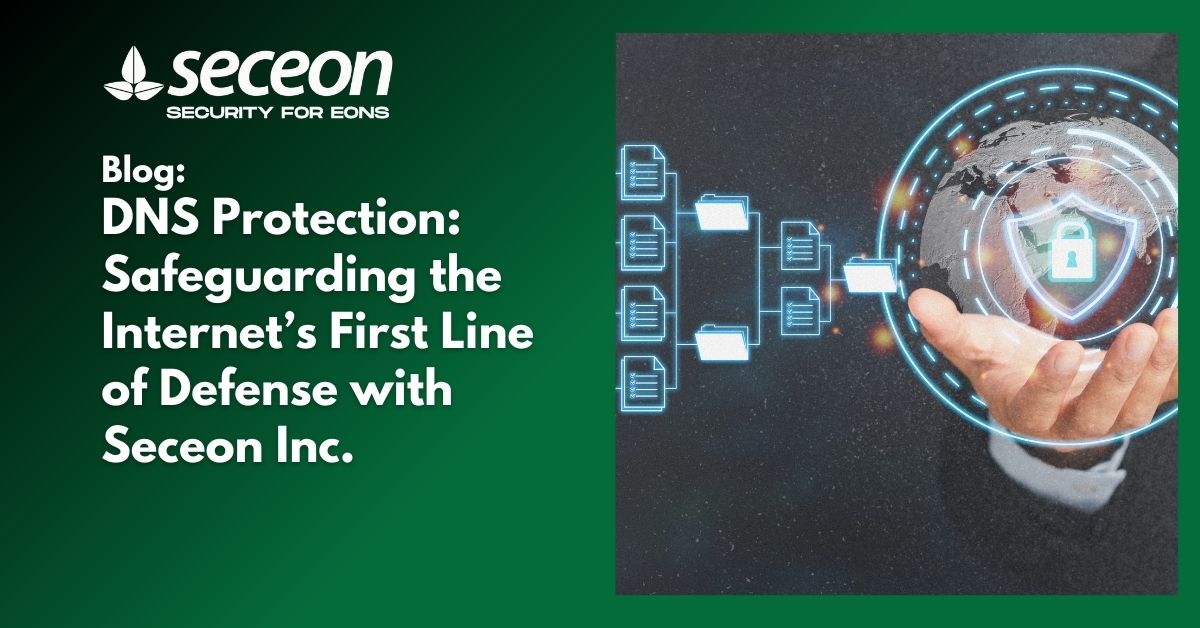
Every time you visit a website, send an email, or use a cloud application, a critical step happens behind the scenes: the Domain Name System (DNS) translates human-friendly names (like example.com) into machine-readable IP addresses. DNS is often called the “phone book of the internet.” But while it’s essential, it was never designed with modern cybersecurity threats in mind.
Today, attackers exploit DNS to launch phishing campaigns, redirect traffic, spread malware, or exfiltrate sensitive data. That’s why DNS protection is no longer optional—it’s foundational.
At Seceon, we integrate AI/ML-powered threat detection and Dynamic Threat Modeling (DTM) into DNS protection strategies, giving organizations real-time visibility, blocking malicious queries, and turning DNS into a powerful security tool.
DNS security refers to the technologies, practices, and policies designed to protect the DNS infrastructure from misuse, compromise, or exploitation. This includes:
DNS security strengthens the integrity, availability, and confidentiality of internet communications—making it a crucial layer in enterprise cybersecurity strategies.
DNS sits at the heart of nearly every digital transaction. That makes it both a target and a tool for cybercriminals. Weak DNS defenses can lead to:
In fact, research shows that over 90% of malware campaigns leverage DNS at some stage of the attack lifecycle. Without DNS security, organizations risk breaches, reputational damage, regulatory fines, and lost customer trust.
DNS threats take many forms. Here are some of the most common:
Attackers insert false records into a DNS cache, redirecting users to malicious sites.
Cybercriminals encode data inside DNS queries to bypass firewalls and exfiltrate information.
A form of DDoS (Distributed Denial of Service) where attackers exploit open DNS resolvers to flood a target with traffic.
Unauthorized changes to domain registration or DNS records to redirect traffic or steal business identity.
Using lookalike domains (amaz0n.com) to trick users into visiting malicious sites.
Flooding a DNS server with requests for non-existent domains, overwhelming resources.
Each of these methods exploits DNS weaknesses to launch or conceal attacks, making proactive DNS protection critical.
DNS Security Extensions (DNSSEC) is a protocol that adds cryptographic signatures to DNS data. It ensures that responses to DNS queries come from the correct source and haven’t been tampered with.
Key features of DNSSEC:
However, DNSSEC adoption is uneven. While it greatly strengthens DNS trust, it must be deployed end-to-end (registrar, DNS server, resolver) to be effective.
In addition to DNSSEC, organizations should adopt a layered DNS security strategy that includes:
By combining prevention, detection, and response, enterprises can minimize DNS risk and ensure business continuity.
A DNS firewall is a security solution that filters and blocks DNS requests based on threat intelligence and policy rules.
A DNS firewall is like a security checkpoint at the first mile of internet communication, making it one of the most effective defenses against DNS-based attacks.
DNS isn’t just a vulnerability—it can also be a powerful security asset. With the right analytics and automation, DNS data provides:
By feeding DNS data into SIEM, XDR, and threat-hunting platforms, organizations can transform DNS into a proactive detection and investigation tool.
Traditionally, DNS queries are not encrypted, meaning ISPs, attackers, or intermediaries can monitor them. This raises privacy and security concerns.
For enterprises, balancing privacy and visibility is key. While encryption protects user privacy, it can also blind security teams if not combined with DNS monitoring and security tools.
Seceon integrates DNS protection into its Open Threat Management (OTM) Platform, which powers aiSIEM, aiXDR-PMax, and aiSecurityScore360.
With Seceon, DNS transforms from a blind spot into a real-time security signal and defense mechanism.
Yes. Seceon Inc. provides DNS security as a core component of its AI/ML-powered Open Threat Management (OTM) Platform.
Seceon’s solutions, including aiSIEM, aiXDR-PMax, and aiSecurityScore360, continuously monitor DNS traffic to detect and block malicious activity. By applying Dynamic Threat Modeling (DTM), Seceon identifies suspicious DNS behaviors such as tunneling, data exfiltration, domain spoofing, and connections to command-and-control servers.
Key capabilities include:
In short, Seceon not only protects against DNS-based attacks but also leverages DNS as a proactive security and intelligence tool, giving organizations a stronger defense posture and continuous compliance.
DNS is one of the most fundamental—and vulnerable—parts of the internet. Attackers exploit it for phishing, malware distribution, data theft, and denial-of-service campaigns.
But with Seceon’s DNS protection approach, organizations can defend the internet’s first line of defense with AI/ML-driven visibility, automated responses, and unified risk scoring.
By combining DNSSEC, DNS firewalls, encrypted DNS, and continuous monitoring, Seceon ensures enterprises and MSSPs are protected against DNS-based threats—while transforming DNS into a powerful tool for security, compliance, and resilience.
